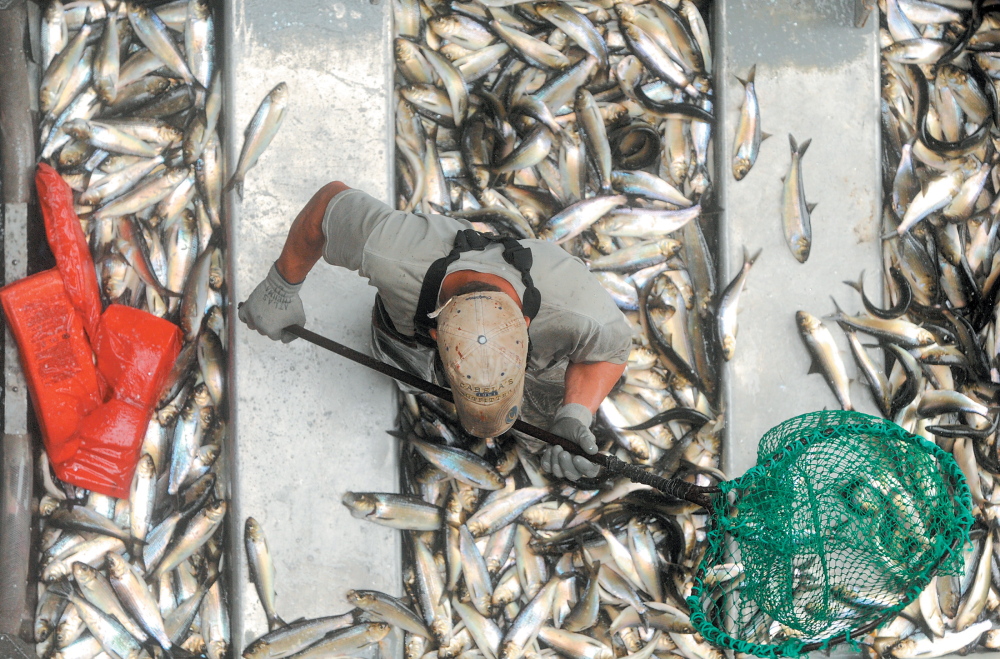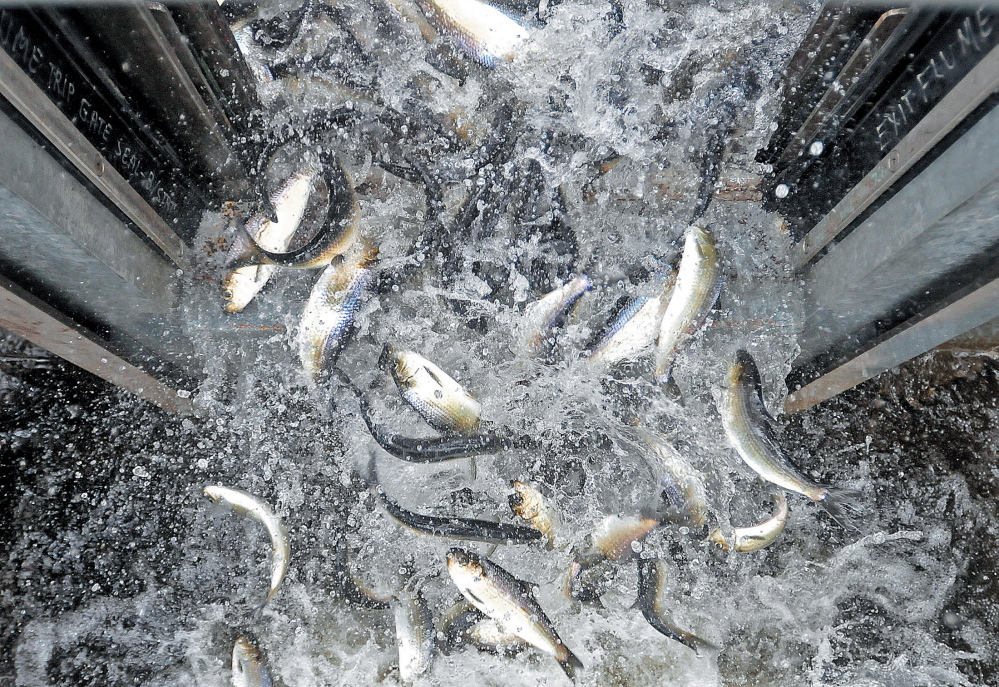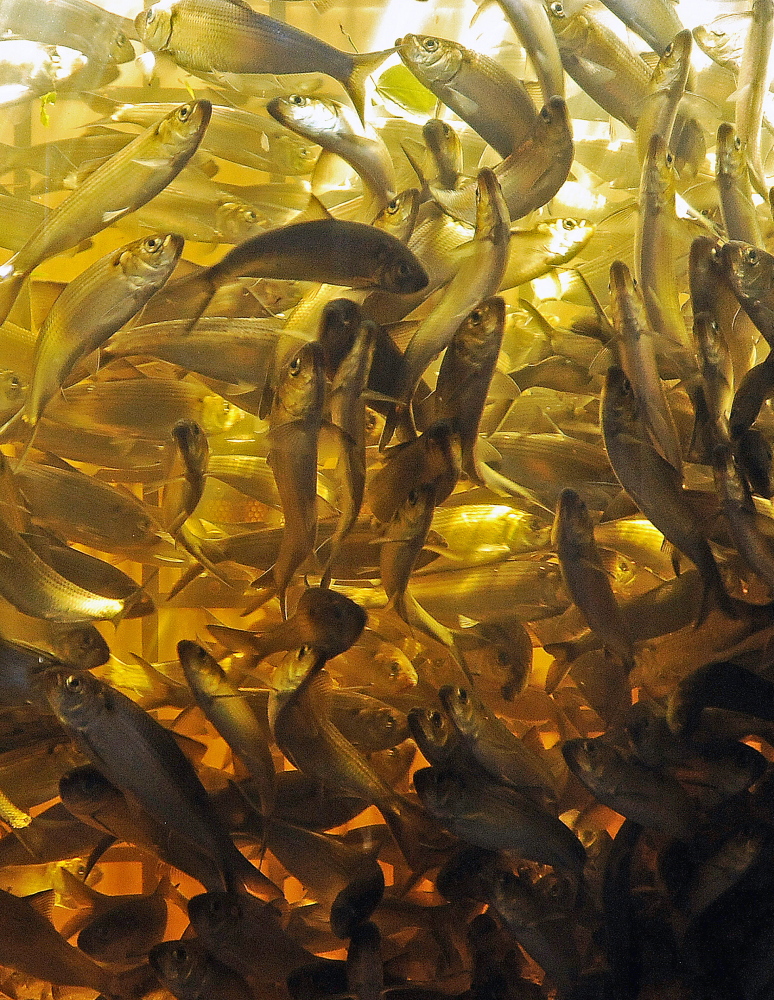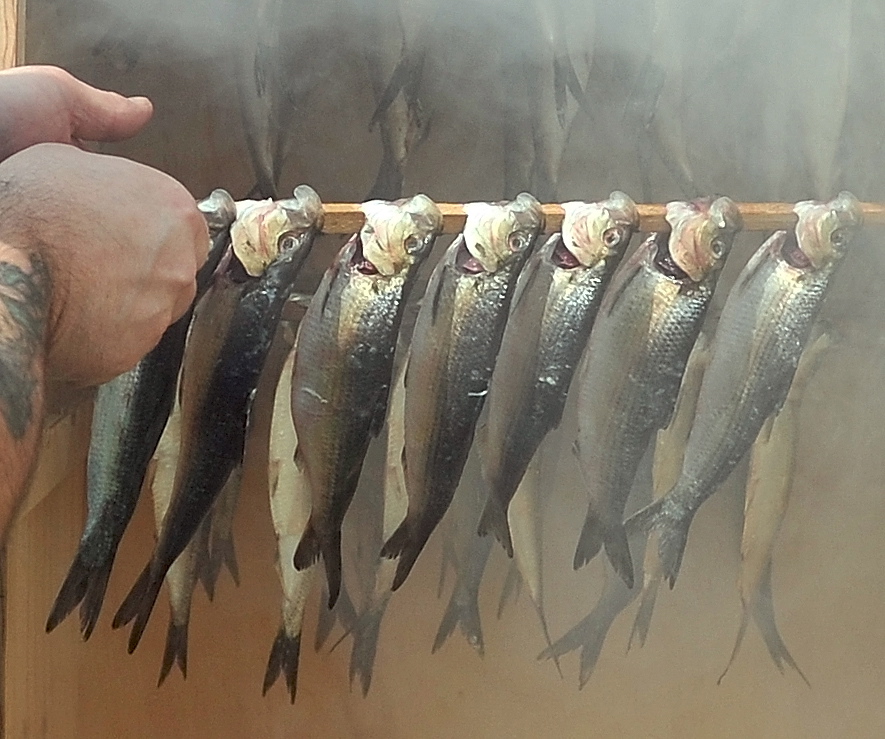In Benton, a small town on the banks of the Sebasticook River, there are two kinds of people: Those who have eaten alewives and those who have not.
The ranks of those who have tried the river fish have been growing for the past couple of years following the town’s efforts to reconnect its citizens with the flavor of a foot-long silver fish that used to be a local culinary staple. For the third year in a row, the town will host its annual Benton Alewife Festival, a celebration of the town’s historic rights to sustainably harvest a portion of the 2 million to 3 million fish that make their way up the river each year around mid-May to spawn. The historic runs were stymied for decades by dams and pollution, but dam removals and environmental and conservation efforts have recently cleared the way for the fish safely pass through Benton and other areas of Maine.
The fish may be back, but what about the public’s appetite for them?
“I’m still bumping into a lot of people who are saying, ‘What the heck’s an alewife?’” said Antoine Morin, the Benton selectman who has taken the lead in organizing the festival. “There’s some education and some eating that needs to be done.”
In order to overcome that basic lack of familiarity with the fish, Morin will kick off this year’s festivities with an alewife-themed dinner, part of a sustainable New England seafood dinner series called Eating with the Ecosystem.
In Benton, those who attend the dinner will be served lobster, vegetables and a variety of alewives that have been smoked, pan-fried or cooked into chowder.
“I’m also going to give alewife roe a shot this spring,” Morin said. “That’s Maine caviar.”
Morin said he didn’t know how much alewife would be in supply for the festival, but that there’s no danger of running out because “we can literally run down to the Sebasticook and get some.”
After the meal, four speakers with deep alewife credentials will talk about the fish and its place in Maine’s ecosystem, economy and culture.
“I like to call them the alewife whisperers,” Morin said. “You won’t find more alewife knowledge in one room anywhere.”
In the 1800s, the fish, sometimes called smokers, were primarily harvested for human consumption, but now almost all of it is used as lobster bait. Still, some eating traditions have survived, and many old-timers still recall with relish the traditional pairing of a smoker and a glass of ale.
The town nets about $20,000 each year for the harvest, mostly from lobstermen buying alewives as baitfish, while the workers who catch the fish earn about twice that.
If eating alewives were to catch on in a big way, it would increase the asking price for the fish, bolstering the town’s profits. Morin said he’s realistic about the chances alewives have of returning to the dinner plate as a staple, rather than a novelty, but he thinks the public is catching on.
RIVER TO DINNER
Smoking alewives was a habit the region’s earliest European settlers likely picked up from the native Wabanaki, who ate the fish in great quantities. But the tradition of smoking fish and other meat has been practiced by native cultures in Scandinavia, Japan and Australia, among others. as a way to extend the shelf life of a valuable protein that would otherwise spoil quickly. Rob Hebert, an organic farmer from Benton who plans to smoke 1,000 alewives for the dinner and subsequent festival, said he visited Australia once and saw bushmen wrapping meat in leaves and burying them on live coals.
“It was kind of the same thing, but a world apart,” he said.
Hebert uses the same smoking methods residents of Benton did more than 200 years ago – in a wooden smokehouse filled with smoldering green wood and whole fish.
When the fish were plentiful, enterprising locals would sell their alewives to travelers passing through in horse-drawn buggies.
Hebert said the generation gap between the alewife-savvy and the uninitiated is obvious when he gives out free fish samples at the festival each year.
“Aged 55 and down, they have no clue about it,” he said. “The older folks are the ones lined up for the free fish because they know what they’re getting.”
Each year when the alewives begin running, Hebert goes down to the Benton dam. There, Nate Gray, a biologist with the Department of Marine Resources, oversees a $1 million mechanical elevator that lifts loads of fish over the Benton Falls dam, which is owned and operated by Essex Hydro. At the bottom of the dam, a crew of fishermen stands in the waist-deep water, hauling out nets full of fish and dumping them into an empty boat for processing. Lobstermen from all over the state will arrive, buying crates at about $60 each for use as bait.
But a small portion of the fish are destined for the gullets of humans.
Hebert brings hundreds of fish at a time back to his property, where he begins his preparations by filling half of a five-gallon bucket with water.
“To that, you add canning salt until a raw egg will float inside the mixture,” he said. “Then it’s holding all the salt it can possibly stand. Then you pour it over the top of another five-gallon bucket filled just with fish.”
Once the fish are submerged, Hebert weighs them down with plywood weighted with a large stone to compress them.
After 24 hours of soaking, during which the salt begins to dry the fish out, they’re ready to go into the smokehouse, whole and on sticks.
Hebert’s smokehouse, built three years ago by a local company, was fashioned after designs from the 1800s, which he says adds a layer of authenticity to the process.
The sticks that hold the fish were scavenged from an old smokehouse in coastal Damariscotta, where the alewife industry largely survived the damming of the rivers.
Hebert’s smoker has a simple track door in the bottom and uses a cast iron skillet to hold the burning wood. “It just puffs along,” he said.
Usually, it takes 16 to 20 hours of smoking before the fish are ready. During that time as the wood burns, it releases a variety of complex molecules that can impart flavor to the fish; sugar molecules locked into the cellulose fibers of wood caramelize, while the wood imparts a smoky or roasted flavor.
The end product is more tasty than pretty. The first time Hebert smoked a batch of alewives, he was apprehensive about taking his first bite.
“They’re very brownish,” he said. “They almost look burnt.”
He used his dog, a bull mastiff, as a guinea pig. “She ate it right up, so I figured I could try one.”
Dave Dutton, 63, of Vassalboro, runs a smokehouse big enough to walk into, a way to supplement his income when the construction business is slow.
Dutton is not humble about his meat-curing skill. “You got painters and then you got Michelangelo,” he said. “I’ll compete with anyone in the country for smoking.”
Dutton learned how to smoke fish as a kid on his grandparents’ farm, gaining experience in using just the right amount of fuel and brine and smoke for just the right amount of time. “You don’t want to sit down and eat a plate full of salt,” he said.
Mostly, he smokes the chicken, ham and bacon that people bring him. But every year, he gets a handful of requests, always from older people, for smoked alewives. He sells them for $1 apiece.
LOST RECIPES
So what’s an alewife taste like?
Some compare it to salmon, or to suckers, others to freshwater fish. Many say the fried fillets taste a lot like white perch, the piscine equivalent of saying that something “tastes like chicken.”
“Not a heavy fish taste, like herring,” Hebert said. “It’s milder than that.”
There’s also a frequently mentioned drawback. “It’s right full of bones. It’s like biting the back of a dog,” Dutton said. “Nothing but hair bones.”
And like any raw cooking material, the final flavor will depend on what’s done to it in the kitchen – or the smokehouse.
There is plenty of room for disagreement over exactly how to smoke an alewife. For example, Hebert says the type of wood used in the smoker doesn’t matter.
To Dutton, that’s sacrilege. “I use a hickory or maple,” he said. “You ain’t using the right wood, you get a bitter taste on your fish.”
There is also a question as to how whole you want your alewife to be. Dutton’s old-fashioned customers, like Marvel Hutchings of Albion, prefer their innards in.
“They want them done whole,” Dutton said. “They said, ‘Don’t take the eggs out.’”
The eggs are “really delicious,” said Hutchings. “I’ve never had caviar myself, but I’ve heard other people say it’s better than caviar.”
Hutchings grew up in Gardiner in the late 1960s in a family that never lost its alewife-eating tradition. She said many people who live in the Kennebec River watershed considered the alewives – pulled from the river and prepared in makeshift smokers made from barrels – to be a necessary staple. “We ate them by the bushel,” she said. “When you lived by the seasons, and you had eight kids, you ate alewife.”
Hutchings lamented the loss of traditional recipes that provided a wider range of alewife flavors for the discriminating palate. Her own family recipe uses a little more molasses than Dutton does, for example. She doesn’t like them boiled or fried; only the smoking process takes out enough of the oil for her tastes.
“If you’re eating the outside a little bit around the tail and in the fin area, it’s sweet and crunchy, like a chip,” she said. “Then you peel the skin off, and underneath, you’ve got the meat.”
The bones don’t present a challenge to those who know what they’re doing, she said. She uses her fork to rake down the meat from the back of the fish, down toward its tail.
As it has gone from a ubiquitous source of protein to a hard-to-find delicacy, Hutchings has come to think of it as a treat. In her house, they usually eat the smoked fish with crackers and cheese.
SPARE A COD, EAT AN ALEWIFE
If more people come to think of smoked alewife as a tasty afternoon snack, both the fish and the ecosystem that supports them could reap big rewards, according to Sarah Schumann, who founded the Eating With the Ecosystem dinner series two years ago.
“Maximizing the diversity of the seafood we eat can help improve the resilience of both our local ecosystems and our fishing fleets,” she said. “We suggest eating a little bit of everything and trying to make the seafood on your plate resemble the full spectrum of species in the ocean.”
Eating local species, like alewives, in proportion to their abundance is just one way of plugging in to their natural cycle, she said.
“Sustainable seafood isn’t just about what we eat,” she said. “All of our actions affect the marine ecosystems downstream – ecosystems that feed us and sustain fishing jobs, if we take care of them.”
Contact Matt Hongoltz-Hetling at 861-9287 or at:
mhhetling@centralmaine.com
Twitter: @hh_matt
Send questions/comments to the editors.







Comments are no longer available on this story